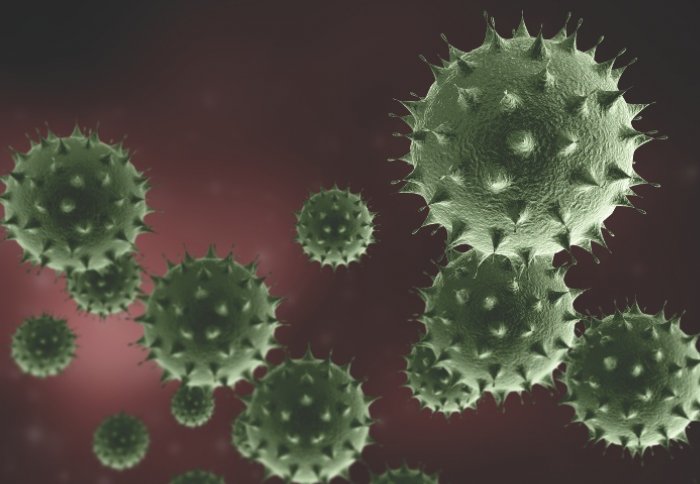

Researchers at Imperial College London have identified a molecule that sounds the alarm when viruses invade our cells.
Our immune system has evolved to recognise distinctive features of infectious agents like bacteria, fungi and viruses in order to fight infections, but some viruses are hard to detect. Now scientists have discovered a molecule that reacts to DNA from viruses and sets off danger signals.
The discovery may help to improve the body’s response to viruses such as HIV and vaccines, and to develop treatments for diseases where the immune system is working abnormally.
The study was carried out by Dr Nicholas Peters with Dr Brian Ferguson as part of Professor Geoffrey Smith’s group in the Department of Medicine. It is published today in the new open-access journal eLife.
The more we understand about DNA sensors, the more we can manipulate the system to encourage better vaccine responses and antimicrobial immune responses.
– Dr Nicholas Peters
Viruses reproduce by invading host cells and hijacking their internal machinery. All viruses have a genetic code, like us. In some, though not all, it is encoded in DNA molecules. These viruses are particularly hard to catch because it is almost impossible to tell their DNA apart from ours. However, our DNA is always inside a cell’s nucleus, a secure central compartment. Viruses have to bring their DNA into the body of the cell as the first step in invasion. By catching it there, DNA sensors discover infection early.
The researchers found that a molecule called DNA-PK sends signals to announce viral attack when it detects DNA in the cell body. DNA-PK was already known for its role in repairing our DNA when it is damaged, for instance by X-rays. This takes places in the nucleus. Previous research had suggested that DNA-PK might also be a DNA sensor in the cell body.
The scientists used cells from normal mice and mice genetically modified to lack DNA-PK. They infected them with vaccinia virus, the one used as a vaccine to eradicate smallpox. In normal cells, DNA-PK bound to the vaccinia DNA and triggered defence signals. In those without DNA-PK, there were no such signals. To confirm DNA-PK’s importance, the modified mice were infected in the skin of their ears. They showed much lower levels of danger signals than normal mice.
“The more we understand about DNA sensors, the more we can manipulate the system to encourage better vaccine responses and antimicrobial immune responses,” says Dr Peters. For instance, the immune system’s first encounter with HIV is thought to be with its DNA after it has entered a cell. Enhancing this reaction could could help to control the infection early.
DNA sensors could also aid the new generation of vaccines, which is based on DNA molecules alone. Scientists hope these will be safer and more effective than today’s vaccines, which use killed or weakened bacteria or viruses, or purified parts of them. Activating DNA sensors could generate stronger alarm signals, which lead to a stronger immune response and a better, lasting immunity to infection.
DNA-PK may offer another surprising lead. “It is extremely likely that DNA sensors are responsible for a decent fraction of various inflammatory processes, such as autoimmune disease. If DNA sensors play a role in such diseases, then inhibition of this system could lead to new treatments.” Autoimmune diseases occur when a sufferer’s immune system attacks their own body, causing inflammation. Inflammation is part of a healthy immune response, but damaging when it goes wrong.
Dr Peters has previously worked on the disease systemic lupus erythematosus (SLE, or lupus), which is caused by immune responses to DNA and involves chronic inflammation throughout the body. It’s highly likely that DNA sensors play a role in initiating these responses, so drugs able to deactivate them may offer a hope of stopping the disease.
Dr Peters did this research during a Faculty of Medicine Medical Research Council PhD studentship, while Dr Ferguson was an Imperial Junior Research Fellow. Financial support also came from the Wellcome Trust and the Brazilian National Council for Scientific and Technological Development.
Reference
B.J. Ferguson et al. ‘DNA-PK is a DNA sensor for IRF-3-dependent innate immunity’ eLife, 18 December 2012. DOI: 10.7554/eLife.00047
Supporters


Article text (excluding photos or graphics) available under an Attribution-NonCommercial-ShareAlike Creative Commons license.
Photos and graphics subject to third party copyright used with permission or © Imperial College London.
Reporter
Eliot Barford
Communications and Public Affairs

Contact details
Email: press.office@imperial.ac.uk
Show all stories by this author
Leave a comment
Your comment may be published, displaying your name as you provide it, unless you request otherwise. Your contact details will never be published.



Comments
Comments are loading...